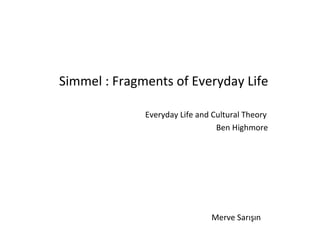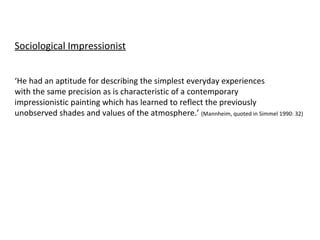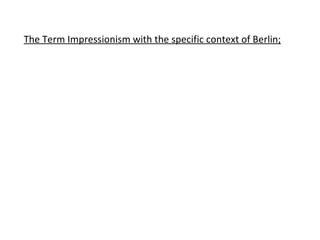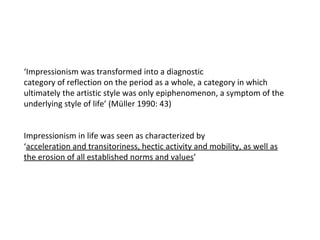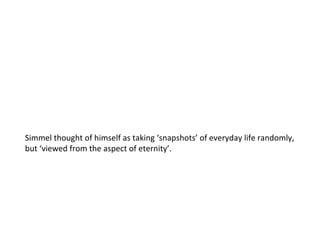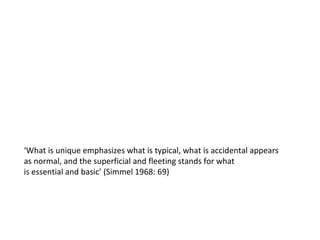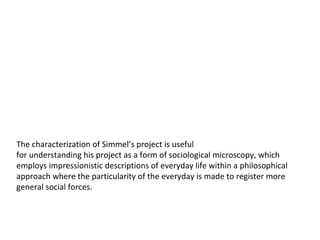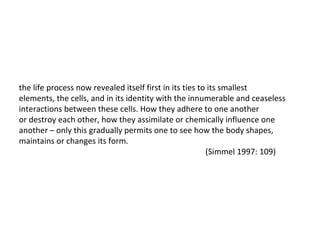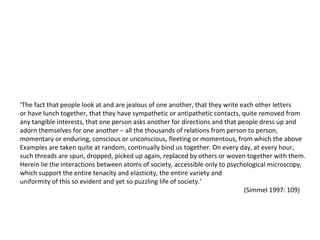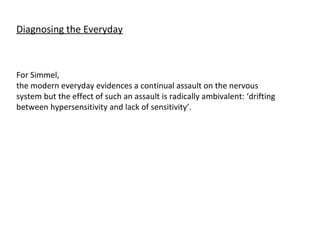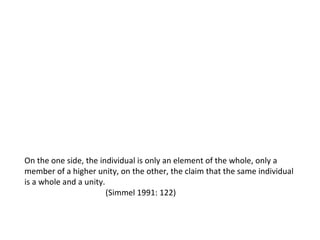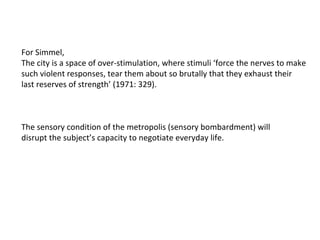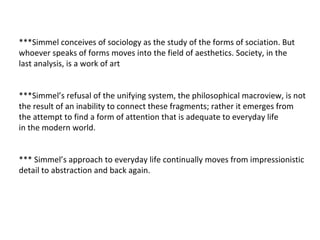Simmel fragments f everyday life
- 1. Simmel : Fragments of Everyday Life Everyday Life and Cultural Theory Ben Highmore Merve Sarışın
- 3. Sociological Impressionist ÔÇÿ He had an aptitude for describing the simplest everyday experiences with the same precision as is characteristic of a contemporary impressionistic painting which has learned to reflect the previously unobserved shades and values of the atmosphere.ÔÇÖ (Mannheim, quoted in Simmel 1990: 32)
- 4. The Term Impressionism with the specific context of Berlin;
- 5. ÔÇÿ Impressionism was transformed into a diagnostic category of reflection on the period as a whole, a category in which ultimately the artistic style was only epiphenomenon, a symptom of the underlying style of lifeÔÇÖ (M├╝ller 1990: 43) Impressionism in life was seen as characterized by ÔÇÿ acceleration and transitoriness, hectic activity and mobility, as well as the erosion of all established norms and values ÔÇÖ
- 6. Simmel thought of himself as taking ÔÇÿsnapshotsÔÇÖ of everyday life randomly, but ÔÇÿviewed from the aspect of eternityÔÇÖ.
- 7. ÔÇÿ What is unique emphasizes what is typical, what is accidental appears as normal, and the superficial and fleeting stands for what is essential and basicÔÇÖ (Simmel 1968: 69)
- 8. The characterization of SimmelÔÇÖs project is useful for understanding his project as a form of sociological microscopy, which employs impressionistic descriptions of everyday life within a philosophical approach where the particularity of the everyday is made to register more general social forces.
- 9. the life process now revealed itself first in its ties to its smallest elements, the cells, and in its identity with the innumerable and ceaseless interactions between these cells. How they adhere to one another or destroy each other, how they assimilate or chemically influence one another ÔÇô only this gradually permits one to see how the body shapes, maintains or changes its form. (Simmel 1997: 109)
- 10. ÔÇÿ The fact that people look at and are jealous of one another, that they write each other letters or have lunch together, that they have sympathetic or antipathetic contacts, quite removed from any tangible interests, that one person asks another for directions and that people dress up and adorn themselves for one another ÔÇô all the thousands of relations from person to person, momentary or enduring, conscious or unconscious, fleeting or momentous, from which the above Examples are taken quite at random, continually bind us together. On every day, at every hour, such threads are spun, dropped, picked up again, replaced by others or woven together with them. Herein lie the interactions between atoms of society, accessible only to psychological microscopy, which support the entire tenacity and elasticity, the entire variety and uniformity of this so evident and yet so puzzling life of society.ÔÇÖ (Simmel 1997: 109)
- 11. Diagnosing the Everyday For Simmel, the modern everyday evidences a continual assault on the nervous system but the effect of such an assault is radically ambivalent: ÔÇÿdrifting between hypersensitivity and lack of sensitivityÔÇÖ.
- 12. On the one side, the individual is only an element of the whole, only a member of a higher unity, on the other, the claim that the same individual is a whole and a unity. (Simmel 1991: 122)
- 13. For Simmel, The city is a space of over-stimulation, where stimuli ÔÇÿforce the nerves to make such violent responses, tear them about so brutally that they exhaust their last reserves of strengthÔÇÖ (1971: 329). The sensory condition of the metropolis (sensory bombardment) will disrupt the subjectÔÇÖs capacity to negotiate everyday life.
- 14. ***Simmel conceives of sociology as the study of the forms of sociation. But whoever speaks of forms moves into the field of aesthetics. Society, in the last analysis, is a work of art ***SimmelÔÇÖs refusal of the unifying system, the philosophical macroview, is not the result of an inability to connect these fragments; rather it emerges from the attempt to find a form of attention that is adequate to everyday life in the modern world. *** SimmelÔÇÖs approach to everyday life continually moves from impressionistic detail to abstraction and back again.

